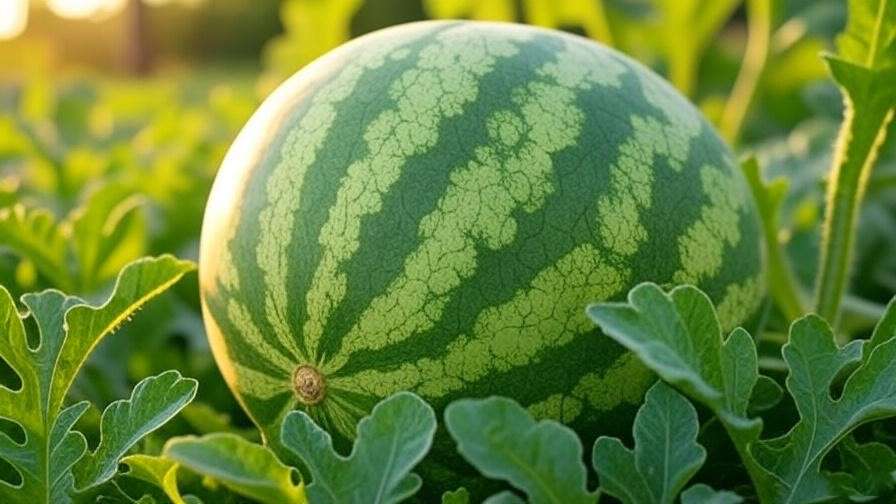Imagine slicing into a juicy, sweet watermelon with a rind that sparkles like a starry night sky. The Moon and Stars watermelon, an heirloom variety, is as beautiful as it is delicious, making it a favorite among gardeners who crave both flavor and flair. Whether you’re a beginner or a seasoned grower, cultivating this celestial fruit can transform your garden into a showpiece. In this guide, we’ll walk you through expert care tips to grow vibrant, healthy Moon and Stars watermelons, ensuring a bountiful harvest. With over a decade of experience in heirloom gardening, I’ve distilled proven techniques to help you succeed. Let’s dive into the magic of growing this unique variety! 🌟
What Is a Moon and Stars Watermelon? 🌟
History and Origin
The Moon and Stars watermelon, a beloved heirloom, first captured gardeners’ hearts in the 1920s when it was introduced by seed saver Peter Henderson & Co. Nearly lost to time, it was rediscovered in the 1980s by seed preservationists, cementing its place in modern gardens. Its name comes from its striking appearance: a dark green rind speckled with bright yellow spots, resembling a moonlit sky. This cultivar’s rich history adds to its allure, making it a must-grow for those passionate about preserving heirloom plants.
Characteristics and Benefits
Moon and Stars watermelons typically weigh 10–30 pounds, with some varieties reaching up to 50 pounds. The flesh is vibrant red or yellow, sweet, and juicy, perfect for summer picnics, salads, or refreshing smoothies. Nutritionally, it’s packed with vitamins A and C, antioxidants, and hydration-friendly water content. Beyond its taste, this watermelon’s unique aesthetic makes it a conversation starter at farmers’ markets or backyard gatherings. Its vigorous vines and reliable fruit set also make it a rewarding choice for home gardeners seeking beauty and bounty.
Ideal Growing Conditions for Moon and Stars Watermelon ☀️
Climate and Temperature Needs
Moon and Stars watermelons thrive in warm climates, requiring daytime temperatures between 70–85°F and nighttime lows above 60°F. As a warm-season crop, they need a long growing season (80–100 days). In cooler regions, consider starting seeds indoors or using black plastic mulch to warm the soil. If you’re in a northern climate, choose a shorter-season cultivar like ‘Yellow Flesh Moon and Stars’ to ensure ripening before frost.
Soil Requirements
These watermelons demand well-draining, fertile soil with a pH of 6.0–6.8. Test your soil using a home kit or send a sample to your local extension service for precise results. Amend poor soils with organic matter like compost, aged manure, or leaf mold to boost fertility and drainage. A nutrient-rich soil base encourages robust vine growth and larger, tastier fruit. Avoid heavy clay soils, which can cause root rot in wet conditions.
Sunlight and Space
Full sun is non-negotiable—aim for 6–8 hours of direct sunlight daily. Moon and Stars watermelons are sprawling plants, with vines reaching 10–15 feet. Space plants 6–8 feet apart in rows, or 3–4 feet apart if trellising. Raised beds or hills improve drainage and maximize root health. For small gardens, vertical growing with sturdy trellises can save space while showcasing the fruit’s stunning rind.
Step-by-Step Guide to Planting Moon and Stars Watermelon 🌼
Choosing the Right Seeds
Start with high-quality, non-GMO heirloom seeds from reputable suppliers like Seed Savers Exchange or Baker Creek Heirloom Seeds. Check seed packets for germination rates (ideally above 85%) and ensure they’re labeled as Moon and Stars to avoid hybrids. Store seeds in a cool, dry place to maintain viability. Pro tip: Soak seeds in lukewarm water for 12 hours before planting to speed up germination.
Starting Seeds Indoors
In regions with short growing seasons, start seeds indoors 4–6 weeks before the last frost. Use seed trays or 4-inch pots filled with a sterile seed-starting mix. Plant seeds ½-inch deep, keep soil moist, and maintain a temperature of 75–80°F using a heat mat if needed. Place trays near a sunny window or under grow lights (14–16 hours daily). Expect germination in 5–10 days. Thin to the strongest seedling per pot to avoid competition.

Transplanting Seedlings Outdoors
Transplant seedlings after the last frost when soil temperatures reach at least 70°F. Harden off seedlings over 7–10 days by gradually exposing them to outdoor conditions, starting with 1–2 hours daily. Dig holes twice the size of the root ball, spacing plants 6–8 feet apart. Mix compost into the planting hole for a nutrient boost. Water thoroughly after transplanting and cover with row covers if nights are cool.
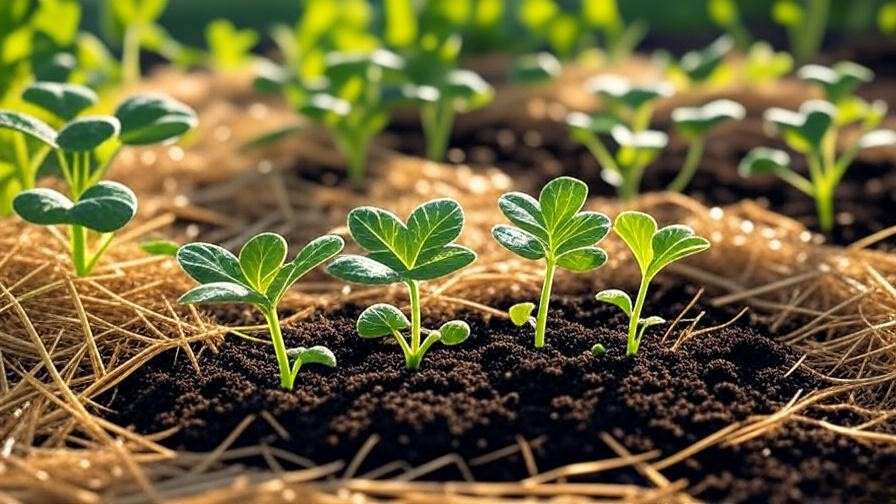
Direct Sowing Option
In warm climates, direct sowing is a simpler option. After the last frost, sow seeds ½-inch deep in hills or rows, placing 2–3 seeds per hole. Thin to the healthiest seedling once they have 2–3 true leaves. Direct sowing reduces transplant shock but requires warm soil and consistent moisture. Weigh the trade-offs: indoor starts offer control, while direct sowing is low-maintenance but weather-dependent.
Caring for Moon and Stars Watermelon Plants 🌿
Watering Needs
Watermelons need 1–2 inches of water per week, depending on weather and soil type. Use drip irrigation or a soaker hose to deliver water directly to the roots, minimizing leaf wetness and disease risk. Water deeply but infrequently to encourage deep root growth. Check soil moisture with your finger: if the top inch is dry, it’s time to water. Overwatering can lead to root rot, while underwatering causes small, flavorless fruit.

Fertilizing for Success
Feed your plants with a balanced fertilizer (e.g., 10-10-10) at planting, then switch to a low-nitrogen, high-phosphorus formula (e.g., 5-10-10) during flowering and fruit set. Organic options like fish emulsion or compost tea work well for eco-conscious gardeners. Apply fertilizer every 2–3 weeks, avoiding overuse, which can lead to lush vines but few fruits. Test soil midway through the season to ensure nutrient levels remain optimal.
Mulching and Weed Control
Mulch with straw, wood chips, or black plastic to retain moisture, suppress weeds, and keep soil warm. Apply a 2–4-inch layer around plants, leaving a small gap near the stem to prevent rot. Hand-pull weeds early to avoid competition for nutrients and water. Avoid deep cultivation near vines, as their shallow roots are easily damaged. Mulching also protects fruit from soil contact, reducing rot and pest issues.
Supporting Vines and Fruit
For space-saving or aesthetic appeal, train vines onto a sturdy trellis or A-frame. Support developing fruit with slings made from old t-shirts or pantyhose to prevent vine stress. If growing on the ground, place straw or cardboard under fruits to keep them dry and clean. Regularly check supports to ensure they can handle the weight of mature watermelons, which can be surprisingly heavy.
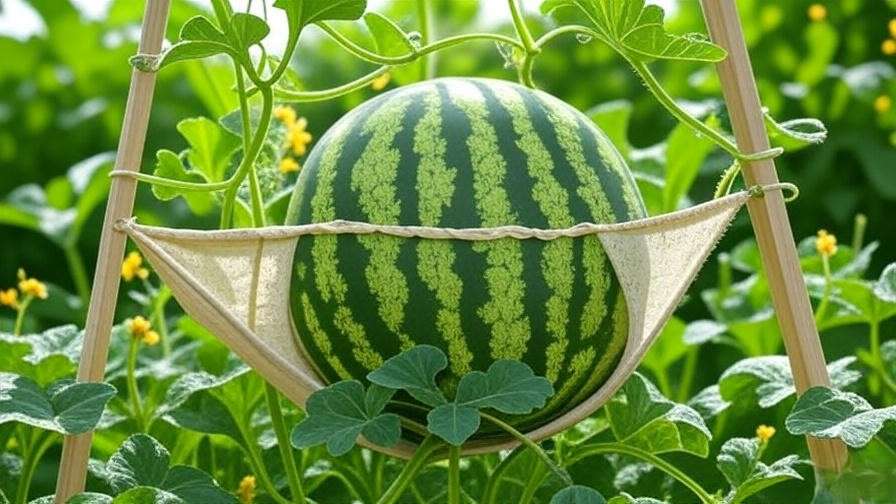
Common Pests and Diseases (and How to Manage Them) 🐞
Pest Control
Moon and Stars watermelons can attract pests like aphids, cucumber beetles, and spider mites. Aphids suck plant sap, causing leaves to curl, while cucumber beetles spread bacterial wilt. Spider mites thrive in hot, dry conditions, leaving webbing on leaves. For organic control, spray neem oil or insecticidal soap every 7–10 days, targeting the undersides of leaves. Introduce beneficial insects like ladybugs to keep aphid populations in check. Companion planting with marigolds or nasturtiums can deter beetles naturally. Use row covers early in the season, removing them during flowering to allow pollination. Rotate crops annually to disrupt pest life cycles.
Disease Prevention
Fungal diseases like powdery mildew (white patches on leaves), downy mildew (yellow spots turning brown), and anthracnose (dark lesions on fruit) can affect watermelons. Bacterial wilt, spread by cucumber beetles, causes sudden vine collapse. To prevent diseases, ensure good air circulation by spacing plants properly and pruning excess foliage. Water at the base, not overhead, to keep leaves dry. Apply organic fungicides like sulfur or copper-based sprays at the first sign of mildew. Remove and destroy infected plant debris to prevent disease spread. Choose disease-resistant cultivars when available, and avoid planting in soil where cucurbits grew the previous year.
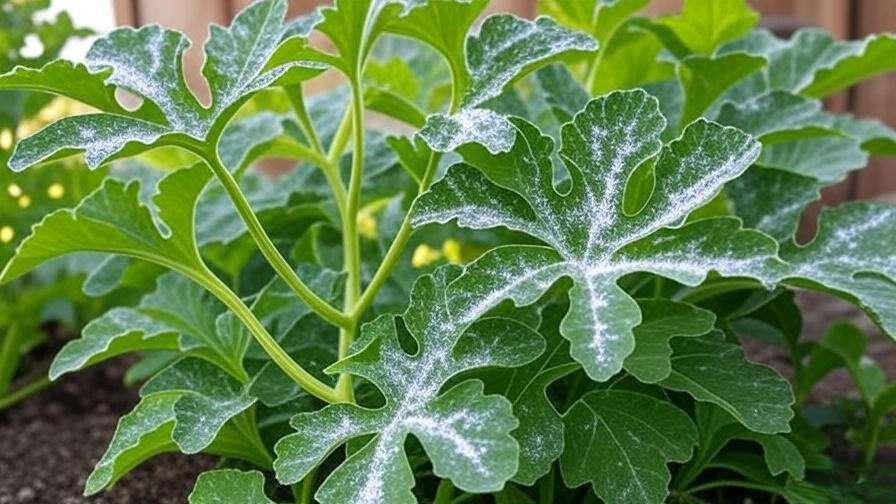
Harvesting and Storing Moon and Stars Watermelon 🍉
When to Harvest
Moon and Stars watermelons typically ripen 80–100 days after planting, depending on the cultivar and climate. Check for ripeness by looking for a yellowing underside where the fruit touches the ground, a dull rind (less shiny than unripe fruit), and a hollow sound when tapped. The tendril closest to the fruit should be brown and dry. Avoid harvesting too early, as immature watermelons lack sweetness. If unsure, test one fruit to gauge ripeness for the rest. For best flavor, harvest in the morning when temperatures are cooler.
Harvesting Techniques
Use clean, sharp pruning shears or a knife to cut the stem about 2 inches above the fruit, avoiding damage to the vine or fruit. Handle watermelons gently to prevent bruising, which can reduce storage life. If harvesting multiple fruits, clean tools between cuts to avoid spreading disease. Place harvested watermelons in a shaded area to avoid sunscald. For market growers, present the fruit’s starry rind prominently to attract buyers.
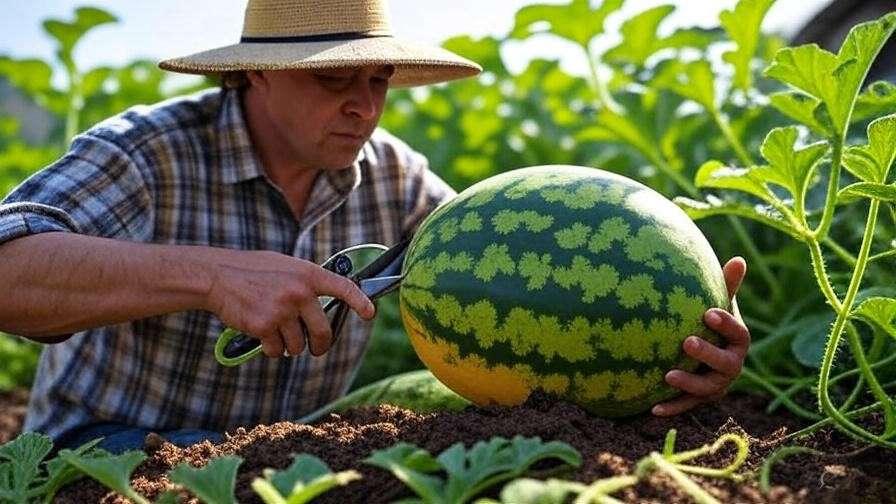
Storage Tips
Store whole Moon and Stars watermelons in a cool, dry place (50–60°F) for up to 2–3 weeks. Avoid stacking to prevent pressure damage. Refrigerate cut watermelon in airtight containers for up to 5–7 days to maintain freshness. For longer storage, cube and freeze the flesh in freezer-safe bags for smoothies or desserts. To preserve heirloom seeds, scoop out the pulp, rinse seeds thoroughly, and air-dry them for 1–2 weeks before storing in a cool, dark place.
Expert Tips for Maximizing Yield and Flavor 🌟
- Companion Planting: Plant marigolds, nasturtiums, or borage nearby to repel pests and attract pollinators like bees, which are essential for fruit set. Avoid planting near potatoes, which can compete for nutrients.
- Pruning for Productivity: Trim secondary vines to focus energy on 2–3 fruits per plant, improving size and sweetness. Remove damaged or diseased leaves promptly to maintain plant health.
- Pollinator Support: Boost pollination by planting pollinator-friendly flowers like zinnias or sunflowers nearby. Hand-pollinate if bee activity is low by transferring pollen from male to female flowers using a small brush.
- Seed Saving: To maintain the heirloom purity of Moon and Stars, isolate plants from other watermelon varieties by 800 feet or use blossom bags during flowering. Save seeds from the healthiest, ripest fruits for next season.
- Soil Health Maintenance: Rotate watermelons with legumes or cover crops like clover to replenish soil nitrogen. Conduct annual soil tests to monitor nutrient levels and pH.
Troubleshooting Common Issues 🛠️
Why Aren’t My Watermelons Growing?
If your plants aren’t producing fruit, poor pollination, nutrient deficiencies, or improper watering may be to blame. Check for bee activity; if sparse, hand-pollinate female flowers (identified by a small bulb at the base). Test soil for nitrogen, phosphorus, and potassium levels, amending with a balanced fertilizer if needed. Ensure consistent moisture, as drought stress can halt fruit development. Thin crowded plants to improve light and air exposure.
Small or Tasteless Fruit
Small or bland watermelons often result from overcrowding, insufficient sunlight, or premature harvesting. Space plants adequately (6–8 feet apart) to reduce competition. Ensure 6–8 hours of direct sun daily, and avoid shading from nearby plants. Wait for full ripeness (yellow underside, hollow sound) before harvesting. Boost flavor by reducing watering slightly as fruit nears maturity, concentrating sugars.
Vine Wilting or Yellowing
Wilting or yellowing vines may indicate environmental stress, pests, or disease. Check soil moisture: overwatering causes root rot, while underwatering stresses plants. Inspect for cucumber beetles or signs of bacterial wilt (sudden collapse). If disease is suspected, remove affected vines and apply organic fungicides to healthy plants. Improve drainage and air circulation to prevent recurrence. For stressed plants, apply a diluted seaweed extract to boost resilience.
FAQs About Growing Moon and Stars Watermelon ❓
- How long does it take for Moon and Stars watermelon to grow?
Typically 80–100 days from planting to harvest, depending on the cultivar and growing conditions. Start indoors in cooler climates to extend the season. - Can I grow it in containers?
Yes, but choose dwarf varieties like ‘Bush Sugar Baby Moon and Stars’ and use large containers (15–20 gallons) with good drainage and trellis support. - What’s the best way to prevent pests organically?
Use neem oil, companion planting with marigolds, and row covers early in the season. Introduce beneficial insects like ladybugs for natural pest control. - How do I know when my watermelon is ripe?
Look for a yellow underside, a dull rind, a dry tendril near the fruit, and a hollow sound when tapped. Harvest in the morning for best flavor. - Can I save seeds from my Moon and Stars watermelon?
Yes, select seeds from the ripest, healthiest fruit. Rinse, dry thoroughly, and store in a cool, dark place to maintain heirloom purity.
Conclusion: Grow Your Own Celestial Watermelons! 🌜
Growing Moon and Stars watermelons is a rewarding journey that combines the joy of gardening with the thrill of harvesting a visually stunning, delicious fruit. With the right care—proper soil, consistent watering, and pest management—you can cultivate vibrant, healthy plants that yield a bountiful harvest. Whether you’re showcasing these starry fruits at a farmers’ market or enjoying them at a summer barbecue, their unique beauty and flavor will leave a lasting impression. Start your Moon and Stars adventure today, and share your progress in the comments or explore our other plant care guides for more gardening inspiration! 🌟













